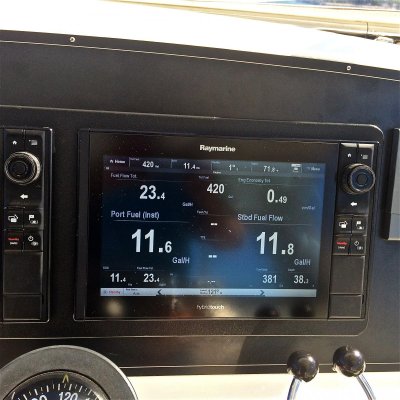Just to keep things interesting, I'll throw out some different views.
First, it's really interesting to me how commonly people talk about the "big three", omitting the largest, Furuno. They would be my first choice, not someone I would forget to add to the list.
Re single vendor, there are two lock-in points with marine electronics. The first is between the radar scanner and the display, and the second is between a fish finder and display. If you use a Multi-function Display (MFD), which is most common on TF-size boats, that in turn locks together the MFD vendor with the radar and fish finder vendor. Alternately, you can get self-contained radars and fish finders with their own displays, or that display on a standard monitor. Bigger boats and commercial boats typically follow the later strategy.
Beyond radar and fish finders, you are not locked into one vendor, though vendors try to encourage you to stick with them. Raymarine still uses proprietary plugs for N2K, for example, where all the other vendors use N2K standard plugs and wires. And most of the vendors let you pop-up a virtual auto pilot control panel on the MFD if you use their auto pilot. That doesn't prevent you from still operating with a dedicated control panel, and one from any vendor. You just give up the pop up screen, not any actual functionality.
Devices that pretty uniformly work across vendors are:
- Autopilots
- Depth sounders
- GPS receivers
- Heading Sensors
- Weather instruments
- Water temp
- Speed through water sensors
- AIS
- VHFs
And if you have dedicated radar and or fish finders, there are a number of things that typically work across vendors. They are:
- Radar target tracking on your chart plotter. Targets tracked on the radar can be plotted on you chart plotter so you can follow them there, as well as on the radar screen.
- AIS targets on Radar. You can feed AIS data to a radar and it will plot the targets including speed and direction, provide CPA, TCPA, etc.
- Locations on a fish finder can be marked and plotted on your chart plotter. So if you see something noteworthy, you can mark it on your chart.
There are some distinct advantages to NOT going single vendor that you should at least be aware of. They are:
- You can pick best of breed for each device. No vendor is the best at everything, so if you go single vendor you will be making compromises in one or more areas. With individual components, integrated with standard interfaces (the way big boats do it), you can pick the best for each device. Furuno radar, Simrad auto pilot, and Coastal Explorer charting, for example.
- When something breaks, or is found to be poorly performing and needs to be replaced, there is much less of a ripple effect through the rest of your equipment. If you find your vendor's radar sucks, as I did, you then discover that replacing it means ripping out everything and replacing it all. It can be very time consuming, and very expensive.
There are also down sides to individual components:
- They typically take up more console space because you have more screens. But increasingly people are typing to fit as much screen space as possible, so above a certain point it really doesn't make any different. But it can be an issue on smaller boats.
- It does take more thought and experience to put it all together. I think most installers push single vendor because it's quick and easy for them to throw everything together and make it work.
Our whole experience is in our blog, starting around here
Adventures of Tanglewood: Electronics summary At the bottom of each article is a "next" and "previous" button to move through the articles.
We first built an integrated, single vendor system, failed miserably, then built from individual components picking best of each, and integrating with only standard, non-proprietary interfaces. We then traveled nearly 20,000 miles that way, and are doing essentially the same thing on the next boat.





